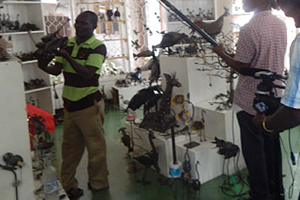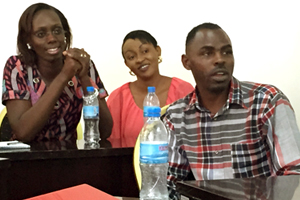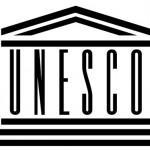Making a TV show where women and men learn to weld animal sculptures and a radio feature on an all-female local soccer team… These are just two examples of stories that participants produced in our recent gender training workshop in Tanzania
Strengthening the Representation and Portrayal of Women in the Media in East Africa ran from 8-12 December 2014, and participants included nine female and six male journalists and NGO workers from Tanzania, Uganda and Rwanda.
Held in partnership with Unesco, and hosted by our member, TBC, in Dar es Salaam, the training aimed to reduce gender stereotyping and improve equality through enabling greater participation of women in the media.
The training provided participants with the practical skills to help them to raise awareness of gender issues in all their projects, while demonstrating how NGOs and the media can work together to produce positive content around such themes. The programme was designed to kickstart further work aimed at improving the position of women working in the media and the portrayal of women by the media.
Activities include robust discussion around good and bad practice in relation to gender and media, field visits, skills training, social media training and the production of content.
Ways of seeing

The participants filmed a TV segment called “Wonder Welders”, which saw women and men with polio learning technical skills to weld scrap-metal animal sculptures that they could sell for income.
This task helped me step into the shoes of the journalists
One of the participants, Prudence Nyamishana, from Uganda’s African Girl Initiative said: “This task helped me step into the shoes of the journalists. Next time I call them for a cover story; I will know what they need for a good story.” She added that the training had helped her reinterpret the way audiences perceived news and see beyond conventional statistically focused journalism.
The 15 people on the course also created a radio feature on a female East African soccer team, comparing how male football teams are portrayed, supported and funded in their countries. They also worked on writing up the personal story of a women selling fruit on the streets on Dar es Salam, her challenges running a business and her own approach to market research.
Ongoing relationships

The practical activities enabled participants to experiment with storytelling techniques to highlight gender issues but also armed them with the skills to cover such stories themselves.
East Africa presents a mixed picture when it comes to female empowerment. For example, women are making great strides in parliament in countries such as Rwanda, but in the media, women made up only a quarter of news subjects in Uganda, according to a Global Media Monitoring Project report. Meanwhile in Tanzania, only 19% of news sources were female across public media, found a Gender Links study.
The course was designed to build ongoing relationships between mainstream broadcasters and local women’s organisations. The Public Media Alliance is to run similar training in India in February 2015, see below.

Funded by Unesco and hosted by the Tanzania Broadcasting Corporation
Related Posts
12th September 2014
African media association leads way with 50% female board
The Southern African Broadcasting…